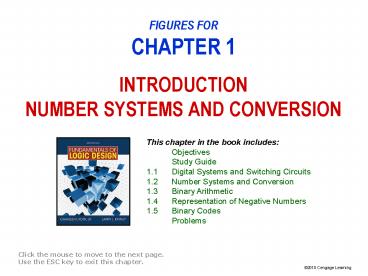FIGURES FOR CHAPTER 1 INTRODUCTION NUMBER SYSTEMS AND CONVERSION PowerPoint PPT Presentation
1 / 25
Title: FIGURES FOR CHAPTER 1 INTRODUCTION NUMBER SYSTEMS AND CONVERSION
1
FIGURES FORCHAPTER 1INTRODUCTIONNUMBER
SYSTEMS AND CONVERSION
This chapter in the book includes Objectives St
udy Guide 1.1 Digital Systems and Switching
Circuits 1.2 Number Systems and
Conversion 1.3 Binary Arithmetic 1.4 Representatio
n of Negative Numbers 1.5 Binary Codes Problems
Click the mouse to move to the next page. Use the
ESC key to exit this chapter.
2
Figure 1-1 Switching circuit
3
Conversion (a)
EXAMPLE Convert 5310 to binary.
4
Conversion (b)
EXAMPLE Convert .62510 to binary.
5
Conversion (c)
EXAMPLE Convert 0.710 to binary.
6
Conversion (d)
EXAMPLE Convert 231.34 to base 7.
7
Equation (1-1)
8
Addition
Add 1310 and 1110 in binary.
9
Subtraction (a)
The subtraction table for binary numbers is 0
0 0 0 1 1 and borrow 1 from the next
column 1 0 1 1 1 0 Borrowing 1 from a
column is equivalent to subtracting 1 from that
column.
10
Subtraction (b)
EXAMPLES OF BINARY SUBTRACTION
11
Subtraction (c)
A detailed analysis of the borrowing process for
this example, indicating first a borrow of 1 from
column 1 and then a borrow of 1 from column 2, is
as follows
12
Multiplication (a)
The multiplication table for binary numbers is 0
x 0 0 0 x 1 0 1 x 0 0 1 x 1 1
13
Multiplication (b)
The following example illustrates multiplication
of 1310 by 1110 in binary
14
Multiplication (c)
When doing binary multiplication, a common way to
avoid carries greater than 1 is to add in the
partial products one at a time as illustrated by
the following example 1111 multiplicand
1101 multiplier 1111 1st partial
product 0000 2nd partial
product (01111) sum of first two partial
products 1111 3rd partial product
(1001011) sum after adding 3rd partial
product 1111 4th partial
product 11000011 final product (sum after
adding 4th partial product)
15
Binary Division
The following example illustrates division of
14510 by 1110 in binary
16
Table 1-1 Signed Binary Integers (word length
n 4)
17
2s Complement Addition (a)
18
2s Complement Addition (b)
19
2s Complement Addition (c)
20
1s Complement Addition (b)
21
1s Complement Addition (c)
22
1s Complement Addition (d)
23
2s Complement Addition (d)
24
Table 12. Binary Codes for Decimal Digits
25
Table 1-3ASCII code(incomplete)

